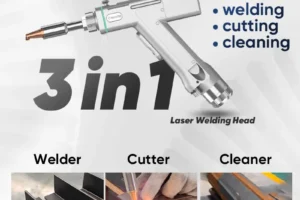Fiber fiber laser cutting is a high-precision and high-efficiency metal processing method widely used in industrial manufacturing and metal processing. It uses a high-energy, dense laser beam to accurately cut complex geometries and thin sheet metal by focusing the energy on a very small area. Compared with traditional mechanical cutting methods, fiber laser cutting has less heat-affected zone and higher cutting accuracy, so it is becoming more and more popular in modern manufacturing.
Table of contents
I. Characteristics of reflective metals and their challenges to fiber laser cutting
II. Tips and tricks for adjusting and optimizing cutting parameters to fiber laser cutting
III. Fiber laser cutting waste treatment and material recovery after cutting
I. Characteristics of reflective metals and their challenges to fiber laser cutting
Reflective metals (such as aluminum and copper) have the characteristics of high reflectivity and thermal conductivity, which makes them present some unique challenges during fiber laser cutting. Due to their strong ability to reflect laser beams on their surfaces, the energy absorption rate is low during fiber laser cutting, which may cause problems such as unstable cutting quality and air film formation, all of which require special attention and effective handling strategies.
II. Tips and tricks for adjusting and optimizing cutting parameters to fiber laser cutting
In order to safely and efficiently cut reflective metals, here are some tips and tricks for adjusting and optimizing cutting parameters:
Laser power and pulse frequency: The laser power needs to be adjusted according to the specific material and thickness, and the use of pulse mode should be considered to improve cutting quality.
Cutting speed and focal position: Optimize cutting speed and focal position to ensure that the laser beam is fully focused and forms an effective cut on the material surface.
Gas selection and flow control: Use appropriate shielding gas (such as nitrogen or oxygen) and control its flow to help stabilize the cutting process and reduce the formation of gas film.
In addition, regular inspection and maintenance of the optical system and adjustment system of the fiber laser cutting machine are also important steps to ensure stable cutting quality.
III. Fiber laser cutting waste treatment and material recovery after cutting
After cutting reflective metal, how to deal with waste and cutting edges is crucial for environmental protection and cost control. Here are some suggestions for handling waste and maximizing material recovery:
Waste treatment: Classify and store waste, and select recycled or reused parts for treatment to reduce negative impact on the environment.
Cutting edge treatment: Treat the cutting edge to ensure its quality and finish for subsequent processing or direct use.
Material recovery: Design a reasonable layout and optimize the cutting path to maximize the utilization of materials and reduce waste.
Through effective waste management and material recovery strategies, not only can production costs be reduced, but also environmental regulations and sustainable development requirements can be met.
IV. Conclusion
Fiber laser cutting of reflective metal is a complex and challenging process that requires comprehensive consideration of factors such as material properties, cutting parameter optimization, and waste disposal. With correct operating skills and effective management strategies, fiber laser cutting of reflective metal can be ensured to be safe and efficient, meeting the dual standards of high precision and environmental protection requirements of modern manufacturing.
KRRASS offers a variety of Fiber Laser Cutting Machines. Please contact us if you need any.





